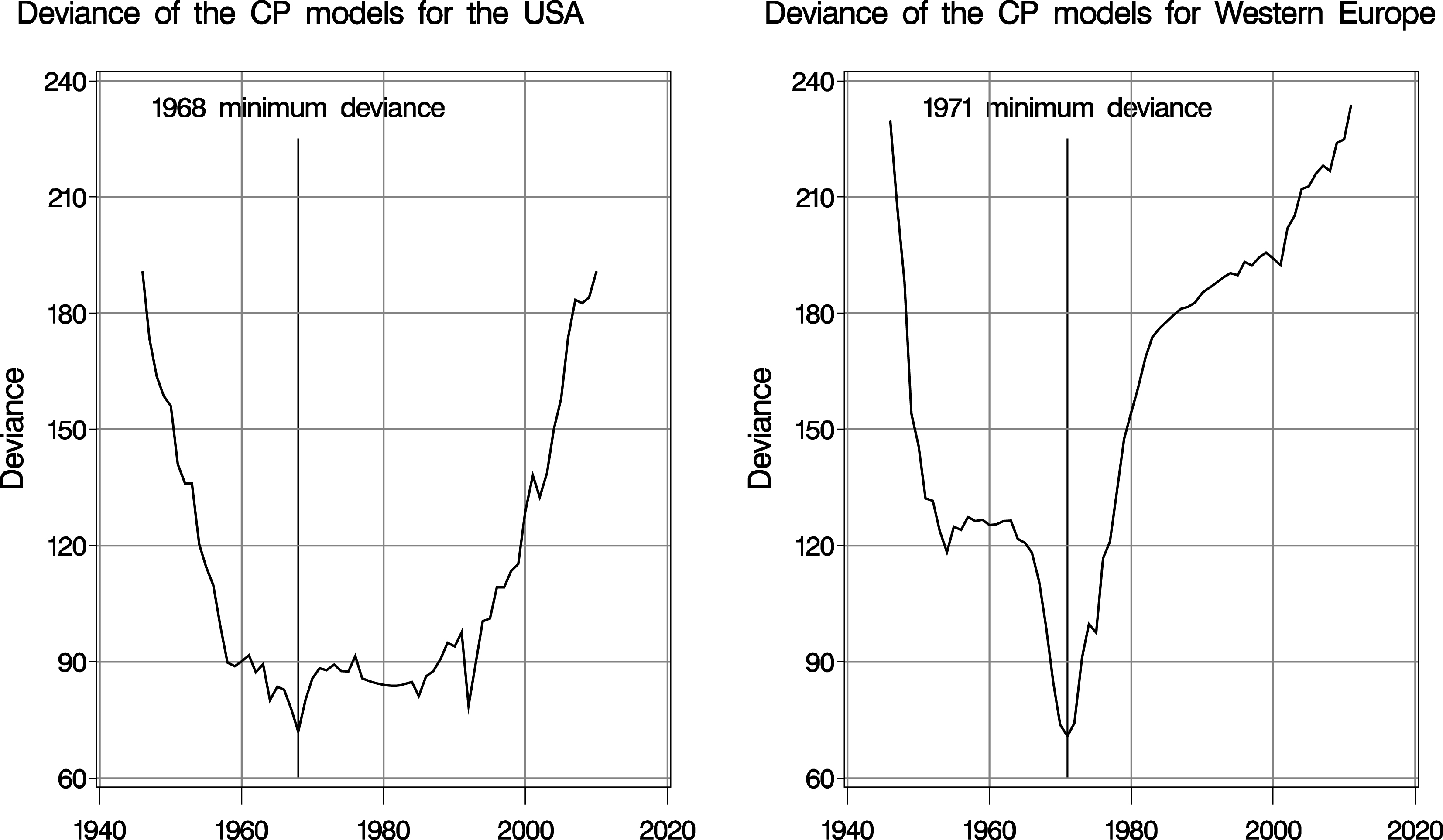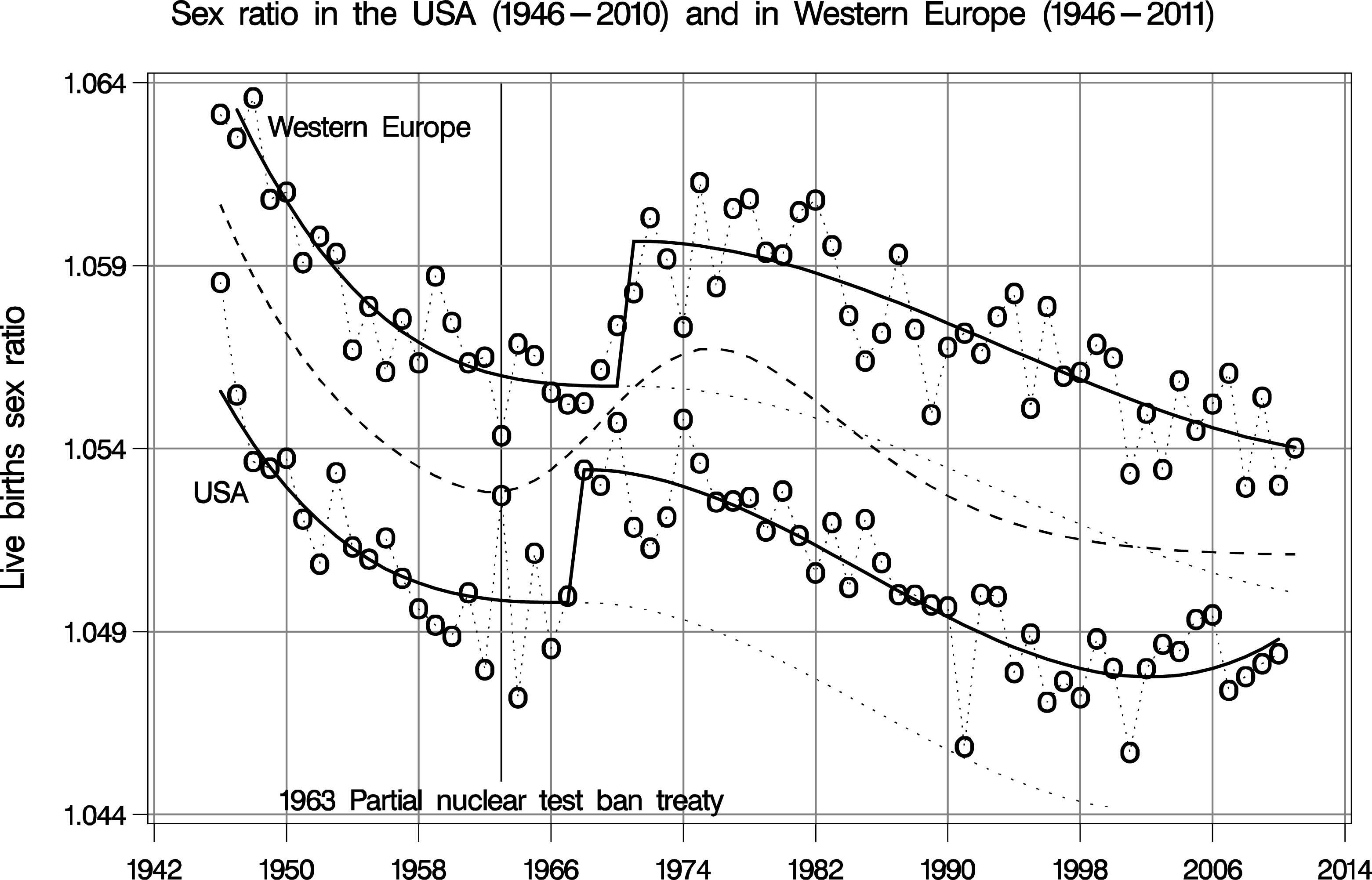Letter to the Editor
Comment on The Letter to the Editor by Alfred Körblein concerning “Atomic bomb testing and its effects on global male to female ratios at birth” by Victor Grech, International Journal of Risk and Safety in Medicine 27 (2015), 35-44. DOI 10.3233/JRS-150641
Sir,
In his recent investigation “Atomic bomb testing and its effects on global male to female ratios at birth” [1], Victor Grech reports a rising birth sex ratio in most regions in temporal association with atomic weapon testing. Therefore, Grech’s observation corroborates corresponding findings across Europe after the nuclear Windscale fire [2, 3], after the Chernobyl accident [4–6], and in Cuba [7].
In his Letter to the Editor in the present issue of “The International Journal of Risk and Safety in Medicine”, Alfred Körblein suggests several improvements in the research field of historical sex ratio trends, e.g. the consideration of annual data in place of the robust temporally categorized approach based on 5-year intervals employed by Grech.
In my letter, I wish to present:
• comments on Körblein’s suggestions for improvements
• a state of the art change point analysis of sex ratio trends.
In his Fig. 1, using annual data, Körblein presents the live birth sex ratio in the USA and in 5 Western European countries and compares those trends to the cesium concentration in grass samples at Rothamsted, England. However, contrasting continental sex ratio trends (USA and Western Europe) with Cs-recordings at only one location (Rothamsted, UK) is not reasonable as exposure depends on the type of nuclides involved and on fallout. Fallout, in turn, depends on weather conditions on a global and local scale: atmospheric transport as well as dry and wet precipitation. Global fallout cannot be represented by recordings at only one location in the UK. Therefore, Körblein’s conclusions that in regard of Fig. 1 it was “not easy to see a direct association between sex ratio and fallout level” and that “the sex ratios were even lowest during the period of highest fallout” are of no surprise.
Without referencing any publications, Körblein sketchily claims “The received wisdom among radiation scientists is that radiation exposures have little or no effect on the sex ratio of live births”. Körblein seems not to be aware of the very many pertinent scientific publications showing distinct associations between ionizing radiation and the sex ratio, not only in man, but also in animals [8–12]. Horst Traut even calculated the mutation rate in humans based on the sex ratio impacted by ionizing radiation [13]. Körblein also ignores the long term significant association of the gender proportion with Chernobyl fallout at the district level in Germany [4] and at the country level in Western/Eastern Europe [5]. These previous findings motivated and support Grech’s results and should be acknowledged accordingly. Körblein also does not take into account the significant sex ratio increase in Northern Europe after the Windscale fire published by Grech [2, 3]. Moreover, Körblein incorrectly implies that he is looking at all of Europe where he actually only looks at Western Europe: “Since the trends of sex odds show a similar time pattern in Europe and the US”. Eastern European trends exhibit distinct increases after Chernobyl and are, therefore, extremely different from the US trend after Chernobyl [5].
In his Fig. 2, Körblein combines the data from Western Europe and from the USA to obtain a smooth overall trend. From a methodological point of view this is problematic or even invalid. Because of the ecological fallacy, this combined curve is neither representative for Western Europe nor for the USA. In relation to the original data in Körblein’s Fig. 1, the combined curve in Körblein’s Fig. 2 entails an extreme overdispersion with deviance = 1503.2 at 125 degrees of freedom. Moreover, the fit of a “bell-shaped” curve superimposed on an exponential decay is not hypothesis driven, and the unsharp/undefined left and right bordes of the “bell-shaped” curves even allow for an effect before the cause. In some data the “bell” is upside down before any corresponding event, which makes this approach by Körblein even more questionable.
For the extremely different sex ratio trends of the USA and of Western Europe, a synoptic change-point analysis based on the minimum deviance criterion (goodness of fit) is carried out in my Fig. 1. The deviance
of a model with parallel trends and a possible upward-jump in a given year between 1946 and 2010 or 2011 is plotted against that year in Fig. 1. These change-point analyses disclose unique, and significant upward jumps in 1968 (USA) and in 1971 (Western Europe). Fig. 2 presents the resulting synoptic trend analysis with optimum change points according to the “minimum deviance criterion” previously applied in our studies [14, 15].
Finally, Körblein criticizes Grech for not providing possible explanations for the observed sex ratio increases. Körblein proposes that strontium injected into the biosphere by the nuclear testing might be the culprit. However, strontium has never been measured in women on representative individual, regional, national, or even global scales. From this point of view, the suggestion of the causative exposure pathway “calculated strontium in women” may well be premature.
References
1 | Grech V(2015) Atomic bomb testing and its effects on global male to female ratios at birthInt J Risk Saf Med27: 13544 |
2 | Grech V(2014) Births and male:female birth ratio in Scandinavia and the United Kingdom after the Windscale fire of October 1957Int J Risk Saf Med26: 14553 |
3 | Scherb H, Kusmierz R, Voigt K(2014) Letter to the EditorInt J Risk Saf Med26: 3173174 |
4 | Scherb H, Voigt K(2007) Trends in the human sex odds at birth in Europe and the Chernobyl Nuclear Power Plant accidentReprod Toxicol23: 4593599 |
5 | Scherb H, Voigt K(2011) The human sex odds at birth after the atmospheric atomic bomb tests, after Chernobyl, and in the vicinity of nuclear facilitiesEnviron Sci Pollut Res Int18: 5697707 |
6 | Grech V(2014) The Chernobyl Accident, the Male to Female Ratio at Birth and Birth RatesActa Medica (Hradec Kralove)57: 26267 |
7 | Scherb H, Kusmierz R, Voigt K(2013) Increased sex ratio in Russia and Cuba after Chernobyl: a radiological hypothesisEnviron Health12: 63 |
8 | Dickinson HO(1996) The sex ratio of children in relation to paternal pre-conceptional radiation dose: a study in Cumbria, northern EnglandJ Epidemiol Community Health50: 6645652 |
9 | James WH(1997) Ionizing radiation and offspring sex ratioJ Epidemiol Community Health51: 3340341 |
10 | Schull WJ, Neel JV(1958) Radiation and the sex ratio in manScience128: 3320343348 |
11 | Vogel F, Motulsky AG(1986) Human GeneticsSpringerBerlin Heidelberg New York Tokyo |
12 | Muller HJ(1927) Artificial Transmutation of the GeneScience66: 16998487 |
13 | Traut H(1969) On the calculation of human mutation rates from changes in sex ratioAnn Hum Genet33: 14551 |
14 | Scherb H, Voigt K(2009) Analytical ecological epidemiology: exposure-response relations in spatially stratified time seriesEnvironmetrics20: 6596606 |
15 | Scherb H, Voigt K, Response to F. Bochud and T. Jung: Comment on the human sex odds at birth after the atmospheric atomic bomb tests, after Chernobyl, and in the vicinity of nuclear facilities, Hagen Scherb & Kristina Voigt. Environ Sci Pollut Res. 2011;18:697–707. (DOI: 10.1007/s11356-012-0767-6). Environ Sci Pollut Res Int. 2012;19(9):4234–41 |
Figures and Tables
Fig.1
Change-point (CP) analyses based on the minimum deviance criterion for the sex ratio trends from 1946 to 2010 in the USA and for the sex ratio trends from 1946 to 2011 in Western Europe (Germany, France, Italy, Spain, and United Kingdom).

Fig.2
Synoptic change point trend analysis of the human secondary sex ratio in the United States of America (USA) and in Western Europe (Germany, France, Italy, Spain, and United Kingdom); optimum change point (jumps) in the USA in 1968 (sex odds ratio 1.0036, 95% -CI: 1.0027–1.0044) and in Western Europe 1971 (sex odds ratio 1.0039, 95% -CI: 1.0029–1.0048); the bold broken line is the double exponential/lognormal model by Körblein.





